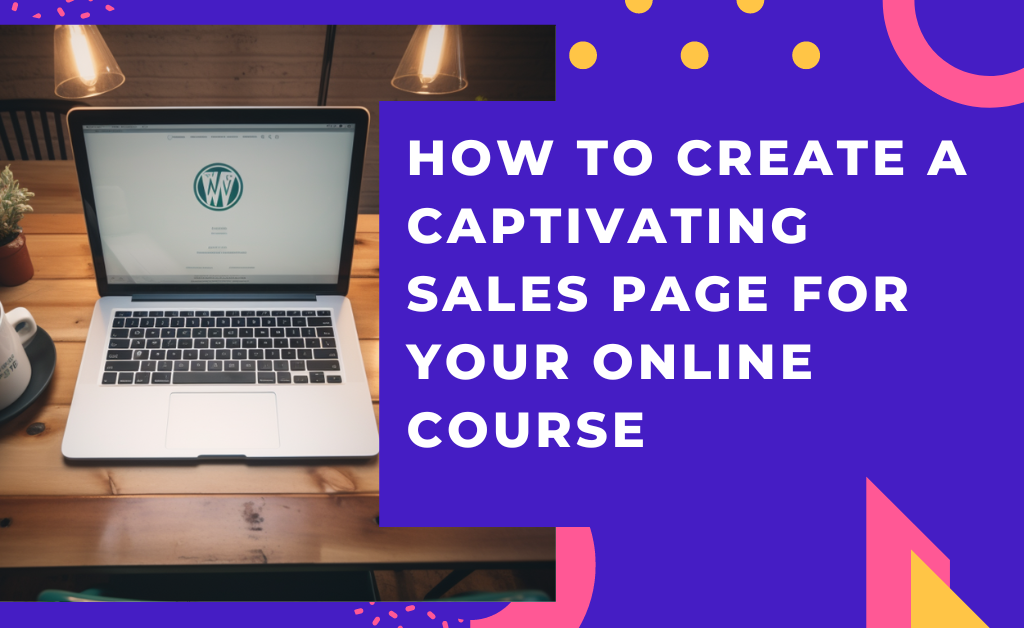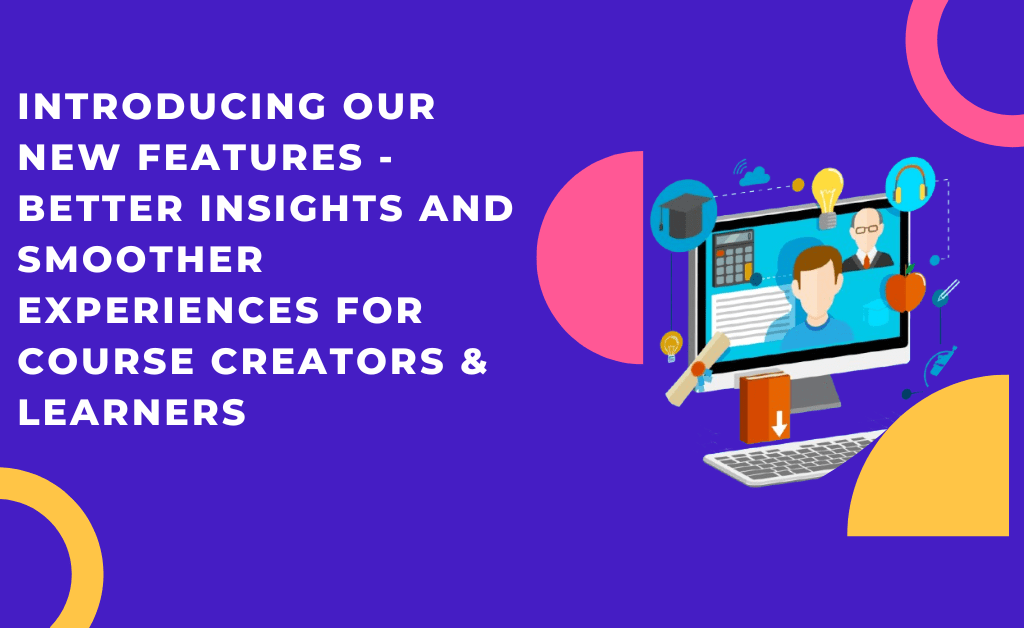A step-by-step guide to creating a sales page for your online course
The Importance of a Well-Crafted Online Course Sales Page
As you complete your online course, having an effective sales page is crucial for attracting potential customers and maximizing conversions. A well-crafted online course sales page serves as a powerful marketing tool that showcases the value of your course and convinces visitors to make a purchase.
-
A step-by-step guide to creating a sales page for your online course
- The Importance of a Well-Crafted Online Course Sales Page
- Step 1: Define Your Target Audience and Unique Selling Proposition (USP)
- Step 2: Write an Attention-Grabbing Headline and Subheadings
- Step 3: Outline Course Modules Clearly
- Step 4: Include Social Proof and Testimonials to Build Trust
- Step 5: Clearly State the Pricing and Payment Options for Your Course
- Step 6: Create Urgency with Limited-Time Offers or Bonuses
- Step 7: Add a Strong Call-to-Action (CTA) to Encourage Conversion
- Step 8: Optimize Your Sales Page for SEO and Mobile Responsiveness
- Summary
The key to creating a successful online course sales page lies in understanding your target audience and aligning your message with their needs and desires. It should clearly communicate the unique benefits and transformation that your course offers, highlighting the specific problems it solves or the skills it helps learners acquire.
To capture attention and maintain interest, a compelling headline is essential. It should be concise yet captivating, instantly conveying the value proposition of your course. Additionally, incorporating persuasive copywriting techniques such as storytelling, social proof, and testimonials can help build credibility and trust with potential customers.
In terms of design, an aesthetically pleasing layout that is easy to navigate can greatly enhance user experience on your sales page. Including visually appealing elements such as high-quality images or videos related to your course topic can also help engage visitors and make a lasting impression.
Furthermore, incorporating clear calls to action throughout the page is crucial for guiding visitors toward making a purchase. Whether it’s a prominent “Enroll Now” button or a limited-time offer that creates urgency, these prompts encourage visitors to take action while emphasizing the value they will gain from enrolling in your online course.
Continuously monitoring and analyzing data from your sales page performance is essential for optimizing its effectiveness over time. Tools like Google Analytics can provide valuable insights into visitor behavior, allowing you to identify areas for improvement and make data-driven decisions to increase conversions.
By implementing these strategies into your course marketing efforts, you can create a persuasive online course sales page that effectively communicates the value of your online courses and drives increased enrollment rates.

Step 1: Define Your Target Audience and Unique Selling Proposition (USP)
When it comes to creating an effective online course, understanding your target audience and ideal customer profile is paramount. By identifying who your course is designed for, you can tailor your content, marketing efforts, and overall approach to meet their specific needs and preferences.
Your target audience refers to the group of people who are most likely to benefit from and be interested in your online course. This could include individuals with a particular skill set, professionals in a specific industry, or even students looking to expand their knowledge in a certain subject area. By understanding their demographics, interests, goals, and pain points, you can develop content that truly resonates with them.
In addition to identifying your target audience, creating an ideal customer profile can provide further clarity on who exactly you are trying to reach. This involves going beyond demographics and diving into psychographics – understanding their motivations, values, lifestyle choices, and purchasing behaviors. By having a clear picture of your ideal customer profile, you can design your online course experience in a way that appeals directly to them.
One key aspect of any successful online course is its unique selling proposition (USP). Your USP sets your course apart from competitors by highlighting what makes it distinctively valuable or different. It could be a specialized teaching method or approach, exclusive access to expert instructors or resources, or even personalized support throughout the learning journey. Communicating this USP effectively through marketing materials will help attract potential students who are seeking exactly what you have to offer.
Finally, let’s not forget about the many benefits that come with taking an online course. For learners looking for flexibility and convenience in their education journey, online courses provide the perfect solution. They allow individuals to learn at their own pace from anywhere in the world without the constraints of traditional classroom settings. Online courses also offer access to a vast range of topics and expertise that may not be readily available locally.
Online courses often provide interactive exercises and assessments that promote active learning and skill development. They can also foster a sense of community through discussion forums and networking opportunities, allowing learners to connect with like-minded individuals from around the globe.
Understanding your target audience and ideal customer profile goes a long way toward creating a successful online course. By identifying their needs and preferences, you can tailor your content and marketing efforts accordingly. Additionally, highlighting your unique selling proposition will help differentiate your course from competitors. Finally, online courses offer numerous benefits such as flexibility, convenience, access to expertise, interactive learning experiences, and community-building opportunities for learners.
Step 2: Write an Attention-Grabbing Headline and Subheadings
When you create your online course sales page, craft an attention-grabbing headline. It can make or break the success of your online course sales page. It should be concise, compelling, and clearly communicate the value proposition of your product or service.
Subheadings are equally important as they allow you to highlight key benefits and features that your product or service offers. These subheadings serve as signposts for readers, drawing their attention to specific aspects that may pique their interest.
To create an attention-grabbing headline, consider incorporating words that evoke curiosity, urgency, or a sense of exclusivity. For example:
“Unlock the Secrets to Explosive Sales Growth with Our Proven Strategies”
This headline immediately captures the reader’s attention by promising valuable insights into achieving remarkable sales growth.
As for subheadings, they should focus on highlighting the most compelling benefits and features of your product or service. Each subheading should be clear and concise while conveying unique selling points. For instance:
“Boost Your Revenue: Increase Conversion Rates with our Data-Driven Marketing Techniques”
This subheading emphasizes one of the key benefits – increasing conversion rates – by leveraging data-driven marketing techniques.
In summary, crafting an effective sales page requires an attention-grabbing headline that sparks curiosity and compels readers to continue reading. Subheadings should then highlight key benefits and features to further engage potential customers and convince them of the value your product or service brings.

Step 3: Outline Course Modules Clearly
When embarking on an online course, you want to have a clear understanding of the course modules, structure, and flow. This knowledge will ensure that you can navigate through the course with ease and make the most of your learning experience.
For starters, let’s focus on the course modules. Each module typically covers a specific topic or set of related topics. These modules serve as building blocks for your learning journey, allowing you to gradually develop your skills and knowledge in a logical sequence. It is important to review the module titles and descriptions provided by the course provider to get an overview of what will be covered.
Next, let’s consider the online course structure. Online courses are often designed with user-friendly interfaces that make navigation simple and intuitive. Typically, you will find a central dashboard or homepage where you can access all the necessary materials for each module. This may include video lectures, readings, quizzes, or assignments.
In terms of flow, online courses generally follow a structured progression designed to guide learners from one concept to another seamlessly. The flow ensures that you build upon previous knowledge and logically understand new concepts. It is common for courses to include assessments at various points throughout the modules to evaluate your students’ understanding and reinforce key concepts.
To make the most out of the online learning experience for your students, approach your course as though you are taking it yourself:
1. Familiarize yourself with the module titles and descriptions before starting.
2. Take note of any prerequisites or recommended background knowledge.
3. Follow the suggested order of completion for each module.
4. Engage actively with course materials such as videos, readings, and interactive exercises.
5. Participate in any discussion forums or group activities provided by the course platform.
6. Seek clarification from instructors or fellow learners if you encounter any difficulties.
7. Regularly review and revise previously learned material to ensure retention.
By having a clear understanding of how your course looks from a student’s perspective, you will be able to structure your course with an efficient flow that takes your student from one module to the next in a logical manner.
Step 4: Include Social Proof and Testimonials to Build Trust
Customer testimonials and success stories are powerful tools that can greatly influence potential customers’ decision-making process. They provide social proof, demonstrating the positive experiences of previous students or clients with a particular product or service. These testimonials offer real-life examples of how a business has helped others achieve their goals, overcome challenges, or improve their lives.
By sharing these stories, businesses can build trust and credibility with their target audience. Prospective customers are more likely to trust the opinions and experiences of others who have already benefited from a product or service. They serve as evidence that the business delivers on its promises and can provide value.
Testimonials can take various forms, including written statements, video testimonials, case studies, or reviews on third-party platforms. Each format has its strengths and appeals to different audiences. By using a combination of these formats, businesses can present a diverse range of success stories that resonate with different types of potential customers.
When crafting customer testimonials or success stories, it is essential to ensure they are authentic and genuine. Genuine testimonials resonate more with readers as they feel more relatable and trustworthy. This can be achieved by using real names and photos (with permission), providing specific details about the customer’s experience, and highlighting measurable results whenever possible.
Including customer testimonials strategically throughout marketing materials such as websites, landing pages, brochures, or social media posts can significantly enhance the overall effectiveness of a marketing campaign. These success stories not only help attract new customers but also reinforce brand loyalty among existing ones.
Customer testimonials and success stories serve as valuable social proof for businesses seeking to build trust with potential customers. By showcasing real-life examples of how their products or services have positively impacted others’ lives, businesses can effectively communicate their value proposition while establishing credibility in the marketplace.

Step 5: Clearly State the Pricing and Payment Options for Your Course
Course fees can vary depending on factors such as the level of expertise required, the length and depth of the course material, and any additional resources or support provided. It’s important to clearly outline prices and payment options on your online course’s sales page.
Payment methods for course fees can range from traditional options such as credit card payments or bank transfers to more modern alternatives like digital wallets or online payment platforms. Offering a variety of payment methods ensures that potential learners have flexibility in choosing the option that best suits their preferences and convenience.
In addition to different payment methods, many educational institutions and online platforms also offer installment plans for course fees. These plans allow learners to divide the total cost into smaller, manageable monthly payments over a specified period. Installment plans make courses more accessible by spreading out the financial commitment.
When considering pricing, payment options, course fees, and installment plans, it is important for educational institutions and online platforms to communicate these details clearly and transparently. Providing comprehensive information about pricing structures, available payment methods, and any installment plan options helps potential learners make informed decisions about their investment in education.
Step 6: Create Urgency with Limited-Time Offers or Bonuses
In the world of marketing and sales, limited-time offers, time-sensitive bonuses, and scarcity tactics have become powerful tools to drive consumer action. These strategies are designed to create a sense of urgency and encourage immediate purchasing decisions.
By placing a deadline or offering exclusive bonuses for a limited period, businesses can tap into the psychological principle of scarcity and motivate customers to take action before it’s too late.
Offers like a pop-up 50%-off coupon that must be used within an hour can turn a potential student into one of your eager new enrollees. Adding a delay to such pop-ups (perhaps a minute or two) will better target students who are interested in your course. If someone browsing has remained on your page for at least a minute, it’s a good bet they are a member of your target audience and are actively considering enrolling in your course.
Step 7: Add a Strong Call-to-Action (CTA) to Encourage Conversion
CTA buttons, also known as Call-to-Action buttons, play an important role in guiding users to take specific actions on a website or landing page.
As the name implies, the purpose of a CTA button is to entice and prompt users to take action. In the context of course enrollment or purchase, the CTA button should clearly communicate what action the user is expected to take. For instance, instead of using generic phrases like “Submit” or “Click Here,” it is more effective to use specific and action-oriented text like “Enroll Now” or “Get Started.”
Furthermore, the design and placement of the CTA button are equally important. It should be visually appealing, easily noticeable, and located in a prominent position on the webpage. The color choice should be attention-grabbing yet consistent with your brand’s visual identity.
To ensure clarity and effectiveness, consider using descriptive language that highlights the benefits or value proposition of enrolling in or purchasing the course. For example, you could use phrases like “Unlock Your Potential” or “Start Your Learning Journey Today.”
Lastly, it’s essential to optimize your CTA buttons for mobile devices since an increasing number of users access websites through their smartphones. Make sure they are easily clickable and appropriately sized for smaller screens.
By incorporating clear instructions on your CTA buttons when promoting course enrollment or purchase, you provide users with a straightforward path towards taking action. This not only saves them time but also increases their confidence in making a decision, ultimately benefiting both them and your business.

Step 8: Optimize Your Sales Page for SEO and Mobile Responsiveness
One of the key aspects of the search engine optimization process is ensuring that your website is mobile-friendly.
With the increasing number of users accessing websites through their mobile devices, it is essential to have a responsive design that adapts seamlessly to different screen sizes. This not only enhances user experience but also improves your website’s visibility in search engine results pages.
Another important factor to consider is page load speed. In the fast-paced world we live in, users expect websites to load quickly and efficiently. Slow-loading pages can lead to higher bounce rates and a negative impact on user experience. Therefore, optimizing your website’s page load speed is important for retaining visitors and improving conversion rates.
Focusing on SEO optimization, mobile-friendly design, and page load speed will create a user-friendly and high-performing website that not only attracts more visitors but also enhances their overall browsing experience.
Summary
In your journey to create and market your online course, every step you take is a pivotal move toward success. Crafting a compelling sales page, understanding your audience, and incorporating effective marketing techniques are essential components of this process. As you delve into this world of digital education, consider the invaluable support of Owwlish, a brilliantly easy online course platform designed for creators of all types.
Owwlish simplifies the complex task of course creation, offering you a seamless platform to bring your educational vision to life. With its user-friendly interface and powerful features, Owwlish empowers you to focus on what you do best – creating outstanding content. Whether you’re a seasoned professional or a budding expert, Owwlish provides the tools you need to build, market, and sell your courses effortlessly.
Harness the potential of Owwlish to not only streamline your course creation process but also to reach a wider audience. In the competitive landscape of online education, Owwlish stands as your reliable partner, ensuring that your courses receive the attention they deserve.
Take the leap into the future of online education with Owwlish. Transform your knowledge into engaging courses, attract eager learners, and make a significant impact. Your educational journey starts here. Embrace the power of Owwlish and witness your online courses flourish like never before. Get started today and unlock the door to endless possibilities in the realm of digital learning.
Related Articles:





